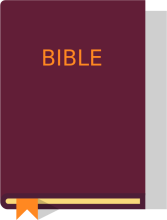Simple timeline of the Bible
By Mark Morgan | Timelines

Here is a simple timeline of the entire Bible, beginning at creation and ending at about 100AD. It won’t give you exact dates, but it might help you to get a sense of scale and order in Biblical events.
Showing more than 4,000 years on one line makes it impossible to show much detail in short periods of time like the life of Jesus or his disciples. This timeline is, therefore, a broad-brush presentation of the events in the Bible.
The left hand side of the timeline shows when the books of the Old Testament were written or the time they describe, but unfortunately, there is not enough room to do the same for the books of the New Testament.
One interesting feature of the Bible is the length of time covered by the first book – Genesis. This one book describes events over a period of almost 2,500 years, while the other 65 books describe the remaining 1,700 or so years. Genesis describes creation, the sin of Adam and Eve, the flood and Noah’s ark, Abraham and God’s promises (including owning the land of Canaan), Isaac, Jacob and the 12 patriarchs – all subjects fundamental to understanding God’s work in the universe.
The book of Exodus tells of Israel leaving Egypt to return to the land promised to Abraham, Isaac and Jacob, while Leviticus, Numbers and Deuteronomy recount the laws God gave to Israel in the wilderness and their travels.
Joshua reports Israel’s conquest of Canaan, which was renamed Israel, then the rest of the Old Testament describes the time spent in Israel until first the northern kingdom and then the southern kingdom were sent into captivity. The return from captivity and the re-establishment of the nation in the land occurred about 500 years before the birth of Jesus and the Old Testament finishes roughly a century later.
Through Israel’s history, God sent many prophets to speak to his people. Some of them wrote down their message and we still have their words today. Often the record starts with the name of the prophet and the ruler(s) during whose reign(s) they prophesied. The introductions show us that these prophets often worked for many years during the reigns of several kings, and also that God didn’t just send one prophet at a time.
Some specific examples demonstrate this:
These four prophets (and probably Jonah as well, see 2 Kings 14: 23-25) all prophesied in overlapping times. Since Isaiah refers only to kings of Judah, he probably only worked in the southern kingdom. Hosea and Amos list kings from both Israel and Judah and may well have delivered their prophecies in both kingdoms. Micah only lists kings of Judah, but since he says that his visions related to Samaria (capital of the northern kingdom of Israel) and Jerusalem (capital of the southern kingdom of Judah), he may have lived in Judah and sent his messages north in a similar form to what we can read now.
The Bible contains a few historical and prophetic books from after the return of the people of Israel to their land. After the book of Malachi, however, we have no surviving words of God until the start of the New Testament, a period often called the 400 silent years.
History suggests that Jesus was probably born in about 4-6BC, which seems incongruous given that BC means “Before Christ”!
Subscribe to our newsletter
Enjoyed this article? Articles on this site summarise the research we do in writing our Bible-based fiction. If you enjoy reading real Bible-based fiction or are willing to give it a try, enter your name and email address in the fields below, then click "Subscribe". You'll get a new micro-tale, or an informative article every week, as well as occasional special offers from Bible Tales Online. You can unsubscribe at any time.
See our Privacy Policy.